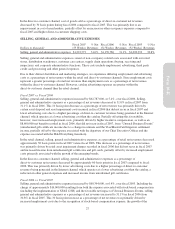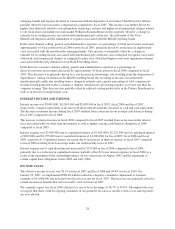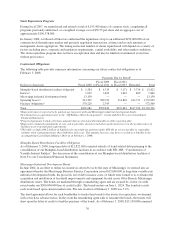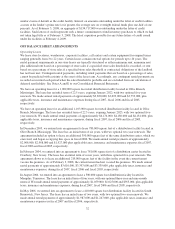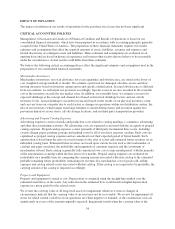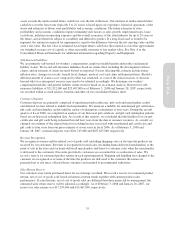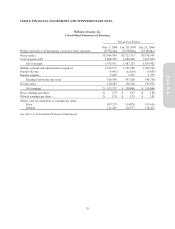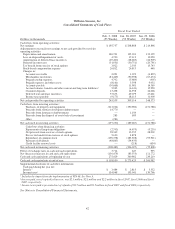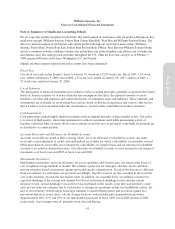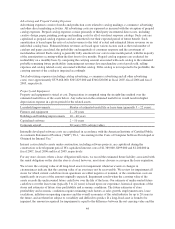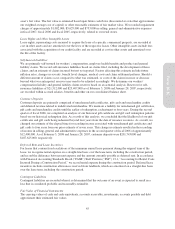Pottery Barn 2007 Annual Report Download - page 46
Download and view the complete annual report
Please find page 46 of the 2007 Pottery Barn annual report below. You can navigate through the pages in the report by either clicking on the pages listed below, or by using the keyword search tool below to find specific information within the annual report.Stock-Based Compensation
We measure and record compensation expense in our consolidated financial statements for all stock-based
compensation awards using a fair value method. For stock options and stock-settled stock appreciation rights
(“option awards”), fair value is determined using the Black-Scholes valuation model, while restricted stock units
are valued using the closing price of our stock on the date prior to the date of issuance. Significant factors
affecting the fair value of option awards include the estimated future volatility of our stock price and the
estimated expected term until the option award is exercised or cancelled. The fair value of the award is amortized
over the expected service period. Total stock-based compensation expense was $26,812,000, $26,759,000 and
$440,000, in fiscal 2007, fiscal 2006 and fiscal 2005, respectively, and is recorded as a component of selling,
general and administrative expenses.
Income Taxes
Income taxes are accounted for using the asset and liability method. Under this method, deferred income taxes
arise from temporary differences between the tax basis of assets and liabilities and their reported amounts in the
consolidated financial statements. We record reserves for estimates of probable settlements of foreign and
domestic tax audits. At any one time, many tax years are subject to audit by various taxing jurisdictions. The
results of these audits and negotiations with taxing authorities may affect the ultimate settlement of these issues.
Our effective tax rate in a given financial statement period may be materially impacted by changes in the mix and
level of earnings.
We adopted the provisions of FIN 48 on January 29, 2007, which clarifies the accounting for uncertain tax
positions. FIN 48 prescribes a process for the recognition and measurement of a tax position taken or expected to
be taken in a tax return and requires us to make estimates of the likelihood that certain tax positions will be
realized upon ultimate settlement. It is reasonably possible that current income tax examinations involving
uncertain tax positions could be resolved within the next 12 months through administrative adjudicative
procedures or settlement.
NEW ACCOUNTING PRONOUNCEMENTS
As of January 29, 2007, we adopted Emerging Issues Task Force (“EITF”) 06-3, “How Taxes Collected from
Customers and Remitted to Governmental Authorities Should Be Presented in the Income Statement (That Is,
Gross versus Net Presentation).” The scope of EITF 06-3 includes sales, use, value added and some excise taxes
that are assessed by a governmental authority on specific revenue-producing transactions between a seller and
customer. EITF 06-3 requires disclosure of the method of accounting for the applicable assessed taxes and the
amount of assessed taxes that are included in revenues if they are accounted for under the gross method. We
present revenues net of any taxes collected from customers and remitted to governmental authorities. The
adoption of EITF 06-3 did not have an impact on our consolidated financial position, results of operations or cash
flows.
In September 2006, the FASB issued SFAS No. 157, “Fair Value Measures,” which establishes a single
authoritative definition of fair value, sets out a framework for measuring fair value, and requires additional
disclosures about fair value measurements. SFAS No. 157 only applies to fair value measurements that are already
required or permitted by other accounting standards, except for measurements of share-based payments, and
measurements that are similar to, but not intended to be, fair value. This Statement is effective for fiscal years
beginning after November 15, 2007 for financial assets and liabilities. In November 2007, the FASB provided a one
year deferral for the implementation of SFAS No. 157 for nonfinancial assets and liabilities reported or disclosed at
fair value in the financial statements on a nonrecurring basis. This Statement will require additional disclosures in
our financial statements. We do not expect the adoption of SFAS No. 157 for financial assets and liabilities to have
a material impact on our consolidated financial position, results of operations or cash flows.
In February 2007, the FASB issued SFAS No. 159, “The Fair Value Option for Financial Assets and Financial
Liabilities – Including an amendment of FASB Statement No. 115.” SFAS No. 159 will permit entities to choose
to measure eligible items at fair value at specified election dates and report unrealized gains and losses on items
36



